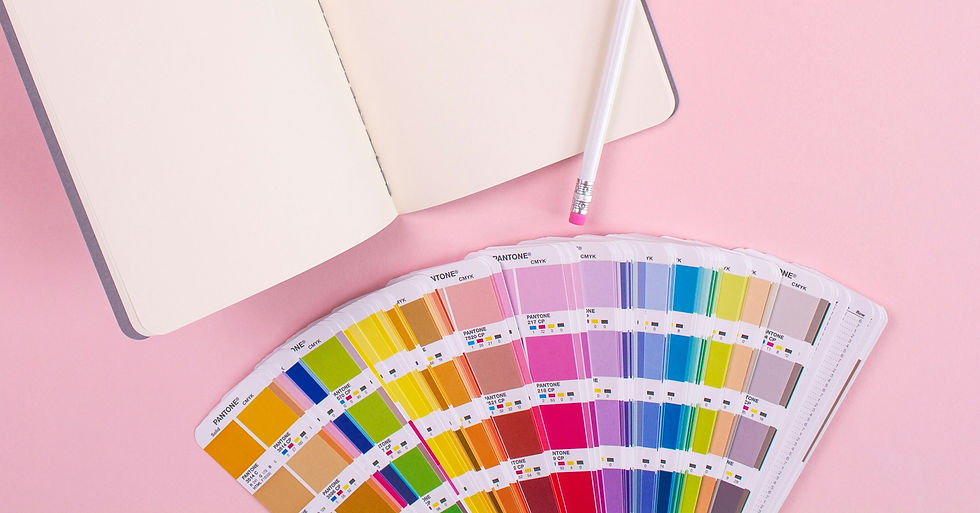Most brand designers are decorators, not strategists
- Nicola McMillan

- Aug 4
- 4 min read
I had a client come to me who'd already worked with two different designers. Her business was doing well - she was hitting six figures and had big plans for expansion. But every time she tried to grow, her brand fell apart.

The first designer had given her a gorgeous logo that looked amazing on her business cards but became a pixelated mess when she tried to use it for outdoor advertising. The second designer created a beautiful colour palette that worked brilliantly for her social posts but looked completely wrong when she worked on her website.
Both designers had given her exactly what she'd asked for. Both had created something visually stunning. But neither had asked the questions that actually mattered: Where do you want your business to be in three years? What marketing channels will you need? How will your brand need to work when you've got a team of 10 instead of just you?
What's happening across the industry
Too many designers are treating branding like a purely visual exercise. They're focused on making things look pretty without understanding how those visual choices will serve the business as it grows.
Don't get me wrong - aesthetics matter. A lot. But when a designer's main concern is whether you prefer serif or sans-serif fonts, rather than how your typography choices will work across every touchpoint your future customers will experience, that's decoration, not strategy.
I see it constantly. Business owners come to me frustrated because their brand "doesn't feel right anymore" or "isn't working how it used to." When I dig deeper, it's always the same issue: their original designer never considered how the brand would need to function as the business evolved.
The questions that actually matter
Strategic brand design starts with understanding your business trajectory, not your aesthetic preferences. When I work with clients, I need to know:
What does success look like for you in three years?
Are you planning to expand internationally?
Will you be hiring a marketing team?
Are you considering new service offerings or products?
How do you want to position yourself against competitors as your market grows?
These aren't nice-to-know questions - they're absolutely essential. Because the brand decisions we make today need to support where you're heading, not just where you are right now.
When I know a client wants to move from one-on-one services to group programmes, that affects everything from the tone of voice we develop to how we structure their visual identity system. When someone's planning to franchise their business model, we need to think about brand consistency across multiple locations from day one.
Why so many designers miss this
Many designers simply don't understand business well enough to ask the right strategic questions. They're brilliant at making things look good, but they've not got the experience of running a business themselves. They don't know what it feels like to outgrow your brand or to realise your visual identity can't stretch to accommodate your growth plans.
That's not necessarily their fault - design education focuses on aesthetics and creativity, not business strategy or revenue forecasting. But it does mean that business owners need to be more careful about who they trust with their brand development.
The designers who do understand business? They're asking about your business model, your growth plans, your target markets, and your long-term vision. They're thinking about how every design choice will serve your business goals, not just your aesthetic preferences.
What decoration-focused design actually costs you
When your brand isn't built strategically, you end up spending more money in the long run. You need rebrands instead of refinements. You need complete overhauls instead of natural evolution. You waste time explaining why your marketing materials don't quite match your website, or why your brand feels disjointed across different platforms.
More importantly, you miss opportunities. When your brand can't adapt to new marketing channels or doesn't work for the audience you want to attract next, you're limited in how you can grow your business.
The client I mentioned earlier? She'd spent thousands with those two previous designers, plus months of time going back and forth on revisions. When we rebuilt her brand strategically, thinking about her expansion plans and long-term goals, she finally had something that could grow with her ambition instead of holding her back.
Strategic branding isn't just about avoiding future problems - it's about creating future opportunities. When your brand is built to scale, you can confidently say yes to growth opportunities instead of worrying about whether your visual identity can handle them.
When you're considering working with a brand designer, listen to the questions they ask. Are they focused on making something that looks good today, or building something that will serve your business for years to come? The difference between those two approaches could determine whether your brand becomes a growth asset or a growth limitation.
Something to think about: if your business doubled in size tomorrow, would your current brand be ready for that success?



Comments